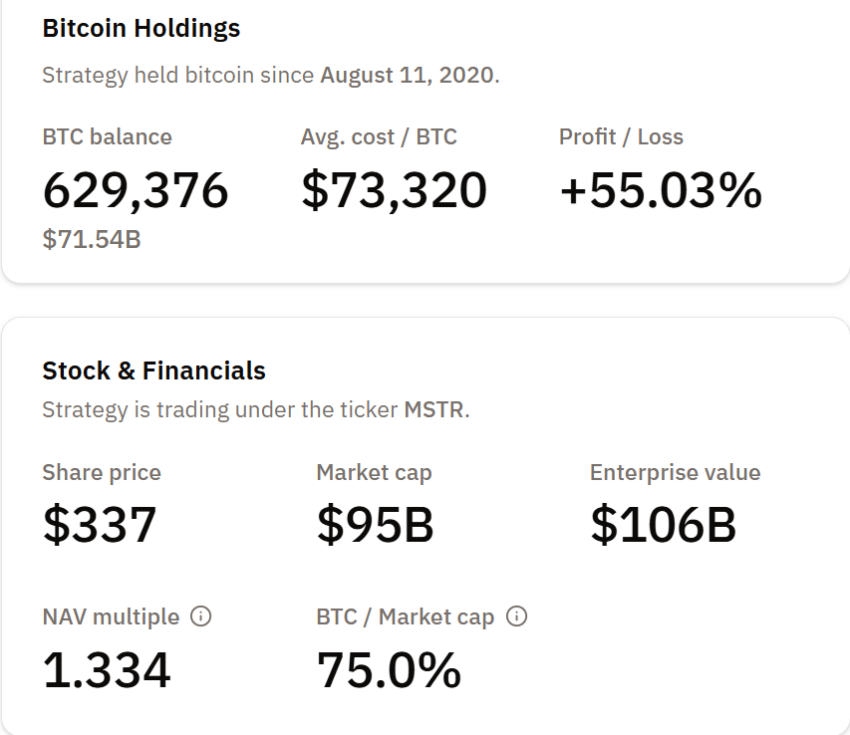MicroStrategy’s Bitcoin Flywheel: Is It Finally Hitting Its First Real Stress Test?
MicroStrategy's billion-dollar Bitcoin bet faces its ultimate reckoning as market volatility spikes. The corporate crypto pioneer built an entire strategy around Bitcoin accumulation—leveraging debt, equity, and corporate cash flow to amass the largest corporate BTC treasury on Earth.
The Strategy Under Pressure
Rising interest rates, regulatory uncertainty, and Bitcoin's notorious price swings create a perfect storm. Every dip tests their leveraged position. Every rally validates their thesis—until it doesn't.
Wall Street's Watching
Analysts scrutinize every move. Critics call it a gamble dressed as innovation. Supporters see genius in conviction. Either way, the entire corporate crypto world holds its breath.
Because in finance, they love a visionary—until the numbers stop adding up.
MicroStrategy’s Premium Breaks From Bitcoin
The divergence raises questions about the sustainability of Michael Saylor’s financial model. Additional concerns include whether new entrants in the Digital Asset Treasury (DAT) market are eroding the company’s unique role as Wall Street’s gateway to Bitcoin.
In hindsight, MicroStrategy’s ability to accumulate bitcoin at scale has always relied on a simple reflexive mechanism. When its stock trades at a premium to net asset value (mNAV), it can issue shares, raise cash, and buy BTC accretively.
This financial alchemy has been the cornerstone of Saylor’s strategy since 2020.
However, according to researcher Joseph Ayoub, the emergence of multiple DATs is weakening that flywheel.
“For the first time in its history, it looks like the discount strongly correlated with Bitcoin’s price has diverged…Perhaps as a function of other DATs launching in the market… I don’t see this premium returning meaningfully again,” Ayoub wrote.
If correct, this WOULD mark a decisive turning point because then MicroStrategy’s ability to fund new Bitcoin purchases through equity issuance may be permanently impaired.
DATs are equity companies that sell shares to purchase digital assets. Since 2020, the Digital Asset Treasury model has mushroomed from roughly $10 billion in NAV to over $100 billion.
By comparison, Bitcoin ETFs (exchange-traded funds) now account for around $150 billion. DATs appeal to investors because they offer equity exposure to crypto assets, often at significant premiums.
Ayoub describes them as modern closed-end funds. Unlike ETFs, most DATs cannot redeem shares for underlying assets. This leaves valuation tied to market sentiment rather than direct redemption mechanisms.
That dynamic recalls the Grayscale Bitcoin Trust (GBTC), which traded at massive premiums before crashing to a 50% discount during the 2022 bear market.
Nic Carter of Castle Island Ventures notes the historical parallels. Quoting a post from Be Water, he compared today’s DAT boom to the investment trust mania of the 1920s, citing many similarities.
excellent post from @bewaterltd. compares the DATs (bitcoin access vehicles I call them) with the investment trust (closed end mutual fund) mania of the 1920s. many, many similarities. https://t.co/mMNEaXRfv1
— nic carter (@nic__carter) July 27, 2025Risks Mount for Saylor’s MicroStrategy
The premium’s decline comes as Saylor faces mounting scrutiny over MicroStrategy’s concentrated exposure to Bitcoin. As BeInCrypto previously reported, some investors view the firm’s recent update as amplifying Bitcoin’s volatility. This would expose equity holders to risks more akin to Leveraged ETFs than a traditional software company.
If MSTR trades persistently at a discount, several consequences follow. Shareholder lawsuits could demand redemptions closer to NAV.
Regulators could reclassify MicroStrategy as an investment company by recalling precedents like Tonopah Mining in the 1940s and the GBTC saga in 2021. Such a MOVE would impose stricter rules or force structural changes.
Against this backdrop, Ayoub warns that equity-financed Bitcoin treasuries have a saturation point.
“After there’s enough supply to absorb artificial & immature DAT demand, the unwind will begin…That is not too distant a future,” he wrote.
Data on Bitcoin Treasuries shows MicroStrategy holds nearly 630,000 BTC with manageable debt levels.

However, the decoupling of its premium may signal that its once-virtuous cycle is breaking down.
If so, the company that turned corporate Bitcoin strategy into financial alchemy may face its toughest test yet from the erosion of its own unique advantage rather than a bear market.

